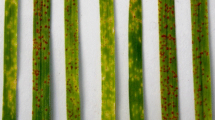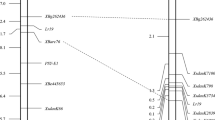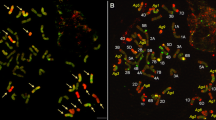Abstract
A set ofT. aestivum-L. elongatum substitution lines were studied on yellow rust resistance at seedling stage, inheritance of the resistance and esterase-5 (Est-5) analysis. The results demonstrated thatL. elongatum carried a new yellow rust resistance gene(s), which was dominant and located on chromosome 3E ofL. elongatum. The biochemical locus encoding Est-5 was also located on chromosome 3E, and was tentatively named Est-E5, which was co-segregant with theYr gene(s) in wheat background. In addition, the transmission frequencies of chromosome 3E in 3A/3E and 3D/3E hybrids selfing were significantly higher than that of chromosome 3E in 3B/3E hybrid, which was probably due to the difference on genetic relationships among A, B, D and E genomes.
Similar content being viewed by others
References
Wang, F. L., Wu, L. R., Xu, S. C.et al., Systematic investigations on the breakdown of resistance in wheat cultivars for Mianyang derivatives to stripe rust (Puccinia striiformis West),Ada Phytopathologia Sinica (in Chinese), 1996, 26(2): 105.
Dvorak, J., Edge, M., Ross, K., On the evolution of the adaptation ofLophopyrum elongation to growth in saline environment,Proc. Acad. Sci. USA, 1988, 85: 3805.
Zhong, G. Y., Dvorak, J., Chromosomal control of the tolerance of gradually and suddenly imposed salt stress in theLophopyrum elongatum and wheat,Triticum aestivum L., genomes,Theor. Appl. Genet., 1995, 90: 229.
Zhang, X. Y., Dong, Y. S., Wang, R. R. C., Characterization of genomes and chromosomes in partial amphiploids of the hybridTriticum aestivum × Thinpyrum ponticum byin situ hybridization, isozyme analysis, and RAPD,Genome, 1996, 39: 1062.
Dvorak, J., Homoeology betweenAgropyron elongatum chromosomes andTriticum aestivum chromosomes,Can. J. Genet. Cytol., 1980, 21: 243.
Dvorak, J., Chen, K. C., Phylogenetic relationships between chromosomes of wheat and chromosome 2E ofElytrigia, Can. J. Genet. Cytol., 1984, 26: 128.
Dvorak, J., Lassner, M. W., Kota, R. S.et al., The distribution of the ribosomal RNA genes in theTriticum speltoides andElytrigia elongata genomes,Can. J. Genet. Cytol., 1984, 26: 628.
Tuleen, N. A., Hart, G. E., Isolation and characterization of wheat-Elytrigiaelongata Chromosome 3E and 5E addition and substitution lines,Genome, 1988, 30: 519.
Liu, C. J., Gale, M. D., The genetical control and tissue-specificity of esterase isozymes in hexaploid wheat,Theor. Appl. Genet., 1994, 88: 796.
Ainsworth, C. C., Gale, M. D., Baird, S., The genetic control of grain esterases in hexaploid wheat. I. Alletic variation,Theor. Appl. Genet., 1984, 68: 219.
Zhang, W. J., Jing, J. K., Hu, H., Transmission of rye 6R chromosome through gametes in wheat,Acta Genetic Sinica (in Chinese), 1995, 22(3): 211.
Chen, P. D., Tsujimoto, H., Gill, B. S., Transfer ofPh I genes promoting homoeologous pairing fromTriticum speltodies to common wheat,Theor. Appl. Genet., 1994, 88: 97.
Author information
Authors and Affiliations
About this article
Cite this article
Ma, J., Zhou, R., Dong, Y. et al. Chromosomal location of yellow rust resistance gene(s) inTriticum aestivum-Lophopyrum elongatum substitution lines. Chin.Sci.Bull. 44, 344–348 (1999). https://doi.org/10.1007/BF02885488
Received:
Issue Date:
DOI: https://doi.org/10.1007/BF02885488




